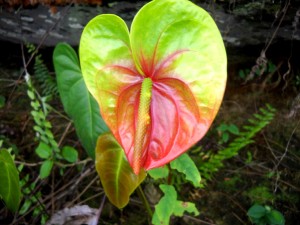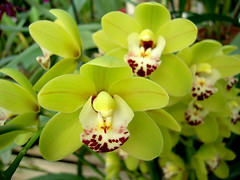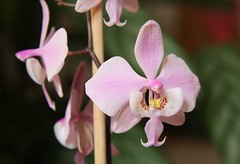Orchid Care
 Caring for Orchids
Caring for Orchids
Do you know how to care for your orchids? If you don’t follow these guidelines, you may be risking the life of your orchid plant.
Orchids are one of the most popular plants in the whole wide world and there are hundreds of various varieties of orchid plants. But despite the diversity found in this incredible family of plants, there are a few general guidelines that you should follow regardless of the species of orchid that you are growing. Ignore them at your peril.
Orchid Care Rules
Adhere to these guidelines to help keep your plant in good health. In the event you do not follow these rules, you might harm or perhaps kill your orchid plant.
- Never pot an orchid in regular soil, use orchid potting mix.
- Never let your orchid stay inside a water soaked pot; make sure that the pot drains well.
- When you do water, make certain you use sufficient water that it drains out from the bottom from the pot to prevent a build up of salts.
- Don’t over-fertilize your orchid. Follow the directions on the fertilizer label.
- Watch for pests and remove them by hand or wipe them off having a soft cloth.
- Ensure adequate space in between your plants to stop the spread of orchid diseases between them.
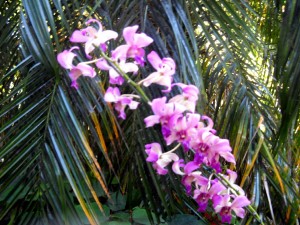 Watering: More Important Than You Think
Watering: More Important Than You Think
Orchids should not be watered too often or you will run the risk of encountering root rot or fungal illnesses. In general, watering once a week is sufficient. You will need to let the media that your orchid is growing in dry in between waterings and you should by no means soak your orchid in water. Its roots need to breathe, so submersing them in water can harm or even kill your plant. You must also mist the leaves and aerial roots of your plant periodically if you live inside a dry area, but avoid getting water on your orchid’s flowers as this can make them rot.
Air Circulation: An Orchid Has to Breathe
Great air circulation is absolutely critical to the well being of your orchid. A frequent cause of fungal infections is poor air circulation. What happens is the air stagnates and water on your plant’s stem and leaves does not dry off as it ought to. When this happens, all sorts of harmful fungus and pests can start to grow and kill your plant.
Temperature: Some Like it Hot
Most orchids favor temperatures in between 65 and 85 degrees. Attempt to help keep them from getting too hot or cold as this can harm or perhaps kill them. They are able to survive brief exposures to temperatures which are outside of this range, but attempt to avoid taking that risk. In the event you do reside in a colder area, attempt to focus on Cymbidium orchids as they are able to withstand colder weather than other varieties of orchids.
Fertilizing: Feeding a Hungry Orchid
Generally you should fertilize your orchid just as it is about to enter its growing season. The growing season starts in the Spring and usually extends to the Fall. As your orchid is growing, its nutritional requirement goes up and so this is the perfect time to feed it. Just look for a fertilizer that is designed for orchids and follow the directions on the label.
Repotting an Orchid
From time to time orchids will need to be repotted, but please bear in mind that the time to repot is often significantly later than many people believe that it is. Orchids appreciate slightly smaller pots than other plants and they also enjoy being slightly root bound, so wait to repot till they’re clearly too big for the pot that they are in. Because there are a lot of orchid lovers out there, most garden shops sell potting mix that’s specially created for orchids. Simply buy orchid potting mix and a slightly bigger pot and repot your orchid in it, using the new potting mix.
Types of Orchids
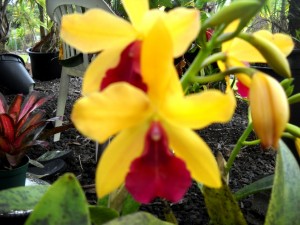 There are thousands of different kinds of orchids. In fact, there are over 22 thousand different species of orchids in the world today and many more are still being discovered. But all orchid plants fall into 880 genera or categories. The ten most popular types of orchids are: Cattleya, Phalaenopsis, Vanda, Dendrobium, Paphiopedilum, Oncidium, Miltonia, Phragmipedium, Odontoglossum and Cymbidium orchids.
There are thousands of different kinds of orchids. In fact, there are over 22 thousand different species of orchids in the world today and many more are still being discovered. But all orchid plants fall into 880 genera or categories. The ten most popular types of orchids are: Cattleya, Phalaenopsis, Vanda, Dendrobium, Paphiopedilum, Oncidium, Miltonia, Phragmipedium, Odontoglossum and Cymbidium orchids.
Though my primary focus is anthuriums, I have been known to grow a few orchids from time to time. But I am by no means an expert on orchids. There are so many different species of orchids that I don’t think anyone can be an expert on all of them. I think that true orchid experts tend to specialize on single family of orchids in order to gain deep rather than wide knowledge of these amazing plants.
Phalaenopsis Orchids
Phalaenopsis are also called Moth orchids. They are great orchids for people who are new to growing orchids because they are some of the toughest orchids around. Some orchids are a little on the weak side, but Moth orchids are tougher and they are more tolerant of small mistakes in care.
Vanda Orchids
Vandas are true to their epiphytic nature. They prefer growing free attached to trees rather than having their roots all cramped up in a pot. They seem to like it when their roots can breathe a little oxygen. So grow them on a tree or in a hanging basket if at all possible. Save your bench space for other plants that need it more.
Cattleya Orchids
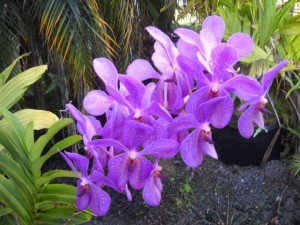 Did you know that there are 113 species of Cattleya Orchids?
Did you know that there are 113 species of Cattleya Orchids?
Well that is what you will find, and they all come from South America. They are named for a man named Sir William Cattley who was the very first individual to grow them outside of their native habitat. These lovely orchids generate large, sophisticated flowers and they are a favorite of orchid breeders. Sometimes they can produce flowers which are six inches across.
They come in almost every color imaginable except for the two colors which you by no means wish to see on your skin, black and blue, unless you are wearing these colors.
They have an interesting structure. The number 3 plays a really important function in their composition. They have three narrow petals and 3 broad petals, but one of their broad petals forms what may look like their mouth. But in contrast to us, they don’t use their mouth to eat, it’s just for show.
Cymbidium Orchids
Cymbidium orchids are also referred to as boat orchids. Why? It’s because they look like boats. Not… Actually I don’t have a clue why they are called this.
There is exactly 52 species of cymbidium orchids. This is a fascinating quantity because this is the same quantity of cards which you will find inside a deck of playing cards. All of these species originated in Asia and a few of the bigger species are able to live at high altitudes.
Cymbidiums have a tendency to produce flowers that are slightly smaller than Cattleyas. In fact, their largest flowers have a tendency to be only four inches across. But they do produce a great quantity of flowers. The majority of the time they will generate a minimum of ten flowers or much more.
They’re a better variety for those of you who live in colder climates. They cannot survive freezing temperatures, but they are able to common deal with temperatures down to 45 degrees. Though, we would struggle to locate those temperatures here in Hawaii.
Dendrobium Orchids
Would you believe that dendrobiums are one of the most plentiful species of orchids?
There are roughly 1,200 species of dendrobiums in the planet these days. These stunning orchids original come from Oceania, which is the region encompassing Asia and Australia. Having a family as large as they have, isn’t it apparent that they would need to come from a large part of the globe?
Another fascinating factoid is that their name derives from the Greek words for tree and for life. They are essentially tree-life or plants that prefer to live on trees. The technical term for this really is epiphytes.
Since they come from such a large region, various species of dendrobiums are adapted to various climatic extremes. Some species prefer to develop in dry locations like the deserts of Australia, while other species like the high altitude cold weather from the Himalayas.
Dendrobiums tend to generate little flowers, but they can generate a lot of them. Some plants can produce up to 100 flowers at a time. Like bears they prefer to sleep in the winter time and do the majority of their growing within the summertime. But, in Hawaii, we tend to have endless summers, so they have a really lengthy growing season here.
Miltonia Orchids
Miltonias were discovered by John Lindley in 1837 in the Brazilian Atlantic Forest. They produce large flowers which last a long time on the plant, but not so long when used as a cut flower. They derive their name from Lord Milton who was an early English orchid fanatic. Miltonia are generally medium to large orchid plants and they also produce medium to large orchid flowers from 4 to 15 centimeters wide.
Finally, I realize that I haven’t covered Odontoglossum, Oncidium, Paphiopedilum and Phragmipedium orchids, yet. But don’t worry. I’ll get to them eventually.
Amazon Bestsellers: Orchid Plants and Books
Green Cymbidium Orchids
Green Cymbidum Orchids come in many pleasing shades of green. They can range from light green to dark green and they can have red, green, white, pink or yellow centers. They are awesome because despite being green they always look like a flower and are not likely to be mistaken for leaves. Whether you are looking for a cut flower or for a great orchid plant, these orchids are ideal specimens for you.
Wedding Flowers
These orchids make great flowers for proms or for weddings. They make exceptional and long lasting bouquets and are also perfect for boutonnieres. The great thing about them is that they can last a very long time as a cut flower. With the proper care they can last several weeks, so you can order them a few days early if you have a special occasion coming up.
These flowers will be shipped to you in a box, while still attached to their stems. Online retailers will ship them with water tubes on the end of their stems to keep them from drying out. When you get them, you need to unpack them and remove their water tubes. Next you need to trim a quarter of an inch from the end of their stems to open up their pores and then you need to place them in a vase filled with clean water. Store them in a cool room at about 65 degrees and keep the room as dark as possible until your big event.
Cymbidum Facts
Stems of these flowers can be up to twenty-three inches long and you will usually find eight to twelve flowers on each stem. And some cymbidiums can have scents that smell like sandalwood or even citrus. They are also known as “boat orchids”, unfortunately I have no idea how they got this name.
Green cymbidium orchids usually bloom during the winter, but of course if you can manipulate their growing environment you can get them to bloom whenever you want them to bloom. If left on the plant, their flowers can last up to ten weeks. So if you have a green thumb you might want to consider growing them, rather than buying them as a cut flower to put into a vase. These orchids used to be very popular in victorian era Europe, because they were able to tolerate cold european winters better than many other species of orchid. They can survive temperatures as low as forty-five degrees, but I wouldn’t push things too far if I were you.
Rare Orchids
Are you interested in buying rare orchids?
One of the top orchid breeders in Hawaii is located about 9 miles away from our farm. He has been developing exotic new varieties of orchids for a number of decades and he has quite a few varieties which are either one of a kind (since they are completely new hybrids that he created) or one of less than a hundred (in the whole world).
I’m thinking of adding a few of these incredibly rare orchids to our catalog, but only if there is interest. I would expect prices to range from $75 to $150 per plant.
So are you interested in orchids that you can’t find anywhere else? If you are, please use our contact form to reach me.
Amazon Bestsellers: Green Orchids
Phalaenopsis Orchid Care
Don’t be tricked by the exotic beauty of Phalaenopsis, they don’t require extraordinary care. Just follow these basic Phalaenopsis Orchid Care guidelines and your plant will bloom for years to come.
Vital Phalaenopsis Watering Tips
Watering your Phalaenopsis is very important. Like all plants, if you forget to water it, it will die. Moreover, these orchids lack a bulb to store moisture, so they are even more prone to dying if you forget to water them. Over watering these plants can also be very harmful. Too much water can cause fungal or bacterial rotting. Use pure water to water them, if you wouldn’t drink it, you probably shouldn’t give it to your plant. If you live in a region with hard water, never give your plant water that has been treated with water softening agents. Aim to use distilled water or water that has been purified by reverse osmosis.
It’s best to water your plant in the morning, so that it has all day to dry out by the evening. Leaving water on your plant or letting your plant sit in a drip tray that is full of water is a bad idea. If you don’t get rid of excess water and especially if you let the roots of your plant sit in water it will eventually die.
In general, your plant should be watered every four to seven days, but you should always keep an eye on the moisture levels of the potting soil. You never want it to become bone dry as this will shock the roots of your plant. But you definitely do not want it to be oversaturated with water either. Essentially, you should water again once the soil gets somewhat dry, but before it gets bone dry.
Correct Light Levels
The Phalaenopsis doesn’t require direct sunlight. In fact, direct sunlight can harm them. If you must place them by a window that gets direct sunlight, try placing a sheer curtain between the window and your plant to filter out a little light. Or just place your plant near a window that gets indirect sunlight. During the winter when light levels are lower, you might want to consider moving your plant to an area that gets a little more light.
Acceptable Temperature Ranges
These types of orchids don’t like to get too cold. If you let them freeze, they will die. The ideal night time temperature for these plants is 62 degrees or higher, and the ideal day time temperature is between 70 and 80 degrees. Thus, these orchids make excellent house plants as these are likely the temperatures that you can find within your home.
Proper Humidity Levels
These plants lack a bulb to store water, so they prefer high humidity. The ideal humidity range is 50 to 70%. If you live in a dry area with low humidity, there are several things that you can do. First you could use a humidifier. Second you could keep your plant in the bathroom, showers serve to elevate the humidity level. Third, you can water your plant regularly. If they are watered regularly they can handle slightly lower humidity levels.
Feeding Your Orchid
Since orchids are grown by so many people, many fertilizer companies make fertilizer designed specifically for orchids. Just find a brand you like and follow the directions on the label. But in general, you will be fertilizing them with a liquid fertilizer about once per week when they are actively growing and about once every three weeks when they are not. If you are using a potting mix with a lot of bark, you may want to opt for a fertilizer with slightly higher levels of nitrogen.
Care Of Flowers
Under ideal conditions, these lovely flowers can bloom up to three times a year once they are fully grown. When they bloom, their blossoms can last for several months. If you would like to induce a higher blooming frequency, clip the flowers stem as soon as the flowers start to fade. You could leave them on until the flowers wilt and completely die, but trimming them as soon as they start to fade will induce the next flower spike to develop sooner.
If the flower buds on your plant die before blooming, then you might want to check if any of the following factors are present: high temperatures, excessively low lighting, too much or too little water, watering with soft water, over-fertilization or excessive cold.
Re-Potting Tips
You could buy bark and moss and various other materials and create your own potting mix, but unless you are a dedicated orchid grower, this is probably not worth the effort. I would recommend that you simply buy a commercial orchid potting mix and be done with it. Remember to repot your plant once per year as the potting mix breaks down after a while. Try to repot during a colder time of the year, like fall or spring, when your plant isn’t flowering.

